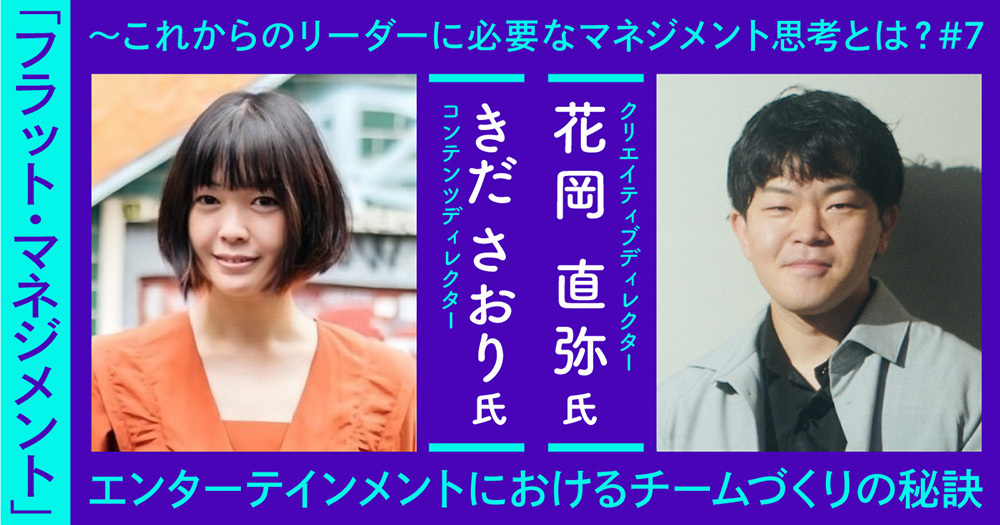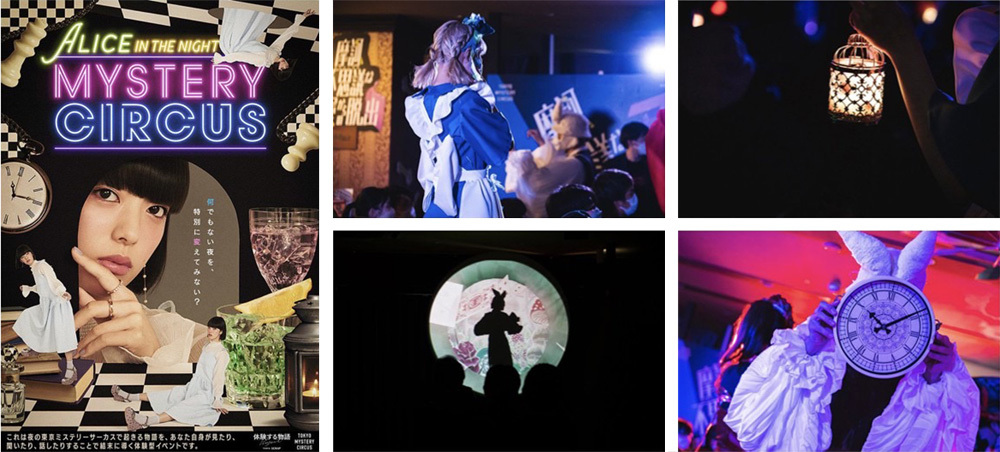Dentsu Inc. Youth Research Department "Wakamon" (hereafter Wakamon), a planning and creative unit with the vision "Designing the Future from Youth," explores emerging new values and researches the management mindset necessary for future leaders.
This research led to the concept of "Flat Management." It's the idea that leaders create "comfortable teams" not by imposing top-down decisions, but by respecting subordinates and team members and engaging with them on an equal, horizontal level.
In July 2023, they published the book " Flat Management: 7 Ways Leaders Create 'Comfortable Teams'" (MDN Corporation).
In this series, we've interviewed prominent figures practicing "Flat Management." Our guests this time are Naoya Hanaoka, Creative Director at Mercury Inc., which operates the next-generation lodging facility "Social Hotel," and Saori Kida, Executive Officer and Content Director at SCRAP Inc., known for creating numerous experiential events like real escape games.
Mr. Hanaoka manages the immersive theater experience "Stay-in-the-Hotel Theater," where guests stay overnight while watching a play, while Ms. Kida participates as a scriptwriter.
Wakamon's Moe Furuyama spoke with them about the key points they focus on when creating new entertainment as a team, the challenges they face, and how they overcome them.
About "The Stay-In-Theater Experience"
This project, run by HOTEL SHE, a hotel operated by Mercury with locations in Osaka and Kyoto, has been staging performances since 2020. For several months, the entire hotel is used, with the front desk and guest rooms also serving as stages. Guests explore the hotel, converse with actors, and experience the story as it unfolds within the space.

First, have thorough conversations to align values and motivations
Furuya: In "stay-in theater," you often build teams with people from diverse backgrounds, including actors. As someone in a management role, what points do you consciously focus on?
Hanaoka: "Stay-in Theater" is an immersive theatrical experience where guests stay at a hotel while watching and participating. Guests move through the hotel, sometimes conversing with actors, as the story unfolds. The creation process is also unique; we often proceed by trial and error. For some productions, we intentionally alter the process from conventional theater methods. When building the team, I consciously reach out to people open to new things and make sure to clearly explain that this is a highly specialized theatrical style.
We spend about an hour per actor during auditions. Twenty minutes are for practical skills, and the remaining forty minutes are for conversation. We explain the unique production process and assess whether the person is open to new things and if we can build a good working relationship.
Furuya: So having a shared mindset is crucial in the pre-team-building stage. How do you handle adjustments once the actual theater-making process begins?
Hanaoka: I believe everyone is a professional with strengths surpassing my own, so I adopt a hands-off approach whenever possible. That said, generating revenue is crucial for the business to succeed. The script, in particular, directly impacts audience satisfaction and also affects merchandise and food sales. Therefore, I sometimes create a rough draft or storyline here first before consulting with them. In those cases, I make sure to thoroughly explain the reasoning behind my choices.
Furuyama: So you place great importance on building relationships and trust in the initial stages. Beyond writing scripts for "Stay-in Theater," Kida-san also manages production for real escape games and immersive theater at SCRAP, where you serve as an executive officer. When forming cross-functional teams with content holders and other companies, what do you consciously focus on from a team management perspective?

An example of the "Experiential Story Project" Kida-san worked on. An immersive theater experience utilizing the entire Tokyo Mystery Circus venue after closing hours. Set in a world where Alice and her friends from Wonderland have wandered into our world through the Rabbit Hole, participants join them to solve "a certain trouble" unfolding that night.
Kida: For me, there are two patterns: building a team from scratch by selecting members, and forming a team through collaboration between companies. The approach to team building differs significantly for each pattern.
When building a team from scratch, I select people needed for the team right from the initial outreach. I explain the project's goals, significance, and what I expect from everyone. If we can reach agreement on that, it usually works out well.
When collaborating between companies, people's motivations and reasons for working can vary quite a bit. So, after sharing my own goals upfront, I make sure to ask, "Honestly, what are you aiming for with this project?"
For example, "I just want to make money" is just as valid as "I want to create something that leaves a mark as a designer." From there, we figure out how to move forward to achieve each person's goals.
I also often discuss my own weaknesses and ask team members about their strengths, weaknesses, what they can tolerate, and what they absolutely dislike. If I determine that a particular team needs a project manager, I add another member. If I think long hours will actually lower motivation, I might shorten the workday. I customize the team and approach based on the situation.
Furuya: It's impressive how you grasp the motivation of every team member.
Kida: I believe differing levels of motivation are a root cause of problems. Someone who thinks "I do it because it's work" and someone who thinks "I'm putting my life into this" have completely different attitudes toward the job. I feel that aligning where everyone's motivation lies from the start reduces the chances of people getting hurt.
"Not being able to do something isn't a bad thing." Leaders take the initiative to disclose their weaknesses.
Furuya: I sense that both Hanaoka-san values conversation and Kida-san prioritizes drawing out team members' intentions. When speaking with management, I sometimes hear that "it's difficult to elicit candid feedback from younger employees." Do you have any specific approaches for this?
Hanaoka: I believe creating an environment where people feel comfortable admitting their weaknesses is essential. In companies, there are times when admitting what you can't do isn't accepted. If you mention a weakness, you often get asked, "So, how are you going to improve that?" Of course, there are weaknesses that should be improved, but values cultivated over time can't be changed, and I feel that influence is significant when it comes to weaknesses.
As Mr. Kida mentioned earlier, to show that this is an environment where weaknesses are accepted, I proactively share my own shortcomings. When I do that, people step forward saying, "I can cover that area," or even, "Actually, that's something I struggle with too."
Furuya: So, by creating an image of a leader who isn't perfect, you're fostering an environment where people want to cooperate. How about you, Kida-san?
Kida: I used to manage a theme park, and back then I was more focused on drawing out the voices of younger staff. I managed about 300 people, ranging from college students to much older employees. Since I had managers directly under me, I realized that bypassing them could diminish their role. I felt I needed to be mindful of both sides.
Back then, my primary focus was to always look cheerful and appear as free as possible. I wanted to avoid giving part-time staff the impression I was hard to approach. Also, when someone approached me wanting to talk, saying "How about an appointment in a week?" was already too late. I had to be able to say, "Let's meet in three hours." To achieve that, I consciously avoided overloading my schedule, always keeping about 30% of my capacity free.
Furuya: That's true. With so many companies working remotely now, creating an approachable atmosphere is crucial.
Kida: Also, like Mr. Hanaoka mentioned, I was conscious of fostering an atmosphere where "not being able to do something isn't a bad thing." Especially in larger teams, I was careful to avoid situations where someone might get singled out.
Furuya: I don't think age itself is the issue, but when managing people, do you consciously consider whether they're older or younger than you?
Hanaoka: Age differences don't really matter. What changes my impression more is whether someone comes from the hotel industry or the theater industry, or what kind of rules they live by. How about you, Kida?
Kida: I used to be looked down upon by older colleagues quite often, though that hasn't happened in the last few years as I've built a track record. I felt I needed that buffer of "being trusted" with older colleagues, so I would explicitly state, "I won't run away no matter what happens, and I'll take final responsibility," and show it in my attitude too.
But now, I don't care whether someone is older or younger, and I often don't ask. I operate with the mindset that "we're on the same playing field, creating the same thing, so it's flat."
The key to solving problems is incorporating an objective perspective
Furuya: What challenges have you faced in your management work so far?
Hanaoka: In my case, problems sometimes arise from differences in how we perceive the issue. While more communication increases the amount of information, if our fundamental understanding of the problem differs, it can lead to a quagmire.
Furuyama: How do you handle those situations?
Hanaoka: I try to avoid having one-on-one conversations whenever possible. I work with Takashi Iijima from Mercury's Entertainment Division in a sort of dual-leadership system. When discussing any problem, I make sure he's involved too. He's particularly good at viewing things objectively and making calm judgments, so I always ask for his opinion.

Takashi Iijima (left), participating in the "Stay-in Theater" project alongside Mr. Hanaoka (right). Regarding team management challenges, Mr. Hanaoka often seeks Mr. Iijima's objective perspective.
Kida: For me, the challenges differ between short-term and long-term projects. In short-term projects like creating a single work, the main issue is often, "If things continue like this, the team might fall apart and we might not be able to deliver something satisfying to the audience." In those cases, I try to resolve it through a mandatory system.
For example, if it's interpersonal issues within the team, I decide whether it's better to facilitate reconciliation or step in myself to move things forward, adjusting the approach and methods each time based on the time remaining and the audience's needs.
For long-term projects involving management issues, emotions become crucial too—like when someone says, "I can't work in a place like this!" In those cases, we write down the facts, emotions, and financial aspects, color-coding them, and discuss how to resolve each. When emotions run high, people often lose sight of the actual facts.
Furuya: So you organize things by color-coding the text. It's clear both of you have consciously applied various approaches to tackle challenges. What kind of team do you want to build going forward?
Hanaoka: I believe everyone has their strengths and weaknesses. Without fear of misunderstanding, I'd say it would be great to create a team that leverages each other's strengths to avoid codependency. While everyone has shortcomings, someone else's strengths can compensate for them, making the team as strong as possible.
Kida: This might be a bit vague, but I think it's crucial that everyone involved is happy. When a project hits the market, I want to be able to say with confidence, "I was part of that." Whether it's "customer feedback," "building a track record," or "making money," I'd love to build a team where we can all share in the positive aspects.
Furuyama: Both of you are managing numerous projects while also focusing on team management—it's been incredibly inspiring. Thank you for sharing your valuable insights today.











